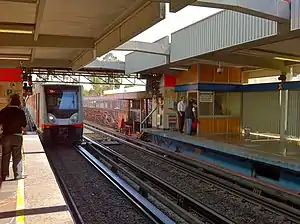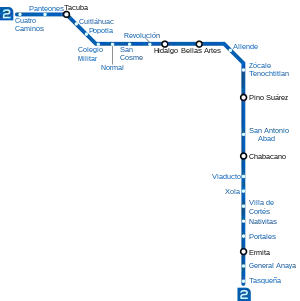Mexico City Metro Line 2
Line 2 is one of the 12 lines of the Mexico City Metro.[2]
| Line 2 / Línea 2 | |
|---|---|
 | |
| Overview | |
| Locale | Mexico City |
| Termini | |
| Connecting lines |
|
| Stations | 24 |
| Service | |
| Type | Rapid transit |
| System | Mexico City Metro |
| Operator(s) | Sistema de Transporte Colectivo (STC) |
| Rolling stock | NM-02 NC-82 NM-79 NM-73 |
| Ridership | 737,396 passengers per day (2019)[1] |
| History | |
| Opened | 1 August 1970 |
| Technical | |
| Line length | 20.713 km (13 mi) |
| Track length | 23.431 km (15 mi) |
| Track gauge | 1,435 mm (4 ft 8+1⁄2 in) standard gauge with roll ways along track |
| Electrification | Guide bars |
| Operating speed | 36 km/h (22 mph) |
The 2 Line is the second oldest in the network, identified by the color blue and runs from West to East and then North to South, turning at the city center. It starts at the border of the city with Estado de México and ends South of the city.
General information
Line 2 connects with Line 7 at Tacuba, Line 3 at Hidalgo, Line 8 at Bellas Artes, Line 1 at Pino Suárez, Lines 8 and 9 at Chabacano and Line 12 at Ermita. It is linked with the Mexico City Light Rail to Xochimilco at the Tasqueña terminal. It used to be served by NC-82 and some NM-83 trains.
It runs under the following roads: Calzada San Bartolo Naucalpan in the stretch from Cuatro Caminos to Panteones, Calzada México-Tacuba from Panteones to Normal, Av. Ribera de San Cosme, Av. México - Tenochtitlan from Revolución to Hidalgo, Av. Hidalgo from Hidalgo to Bellas Artes, Tacuba street, República de Guatemala street, José María Pino Suárez street from Zócalo/Tenochtitlan to Pino Suárez. From San Antonio Abad it runs at ground level over Calzada San Antonio Abad and Calzada de Tlalpan till the terminus of the line in Tasqueña. With 737,396 passengers per day in 2019, it is the busiest line of the Mexico City Metro.
This line was temporarily served by an NM-02 train printed with landscapes and images of Mexico City.
History
Line 2 opened on August 1, 1970, in the stretch Tasqueña–Pino Suárez. Pino Suárez station became the first transfer station of the Mexico City Metro, connecting with Line 1, built one year before.
On September 14, the line was expanded towards Tacuba station.
The last expansion of the line occurred in 1984 when two more stations were built: Panteones and Cuatro Caminos, the latter being the first station of the system to serve the State of Mexico. Cuatro Caminos would remain as the only station to serve the suburbs of Mexico City until 1991, when Line A opened and service reached the municipality of Los Reyes La Paz, in the southeastern part of the State of Mexico with the stations Los Reyes and La Paz.
1975 train crash
This line has seen the worst accident in Mexico City history when on October 20, 1975, when there was a crash between two trains at Viaducto metro station. One train was parked at the station picking up passengers when it was hit by another train that did not stop in time. At least 27 people were killed and several wounded. After this accident, automatic traffic lights were installed in all lines.
Chronology
- August 1, 1970: from Tasqueña to Pino Suárez.
- September 14, 1970: from Pino Suárez to Tacuba.
- August 22, 1984: from Tacuba to Cuatro Caminos.
Rolling stock
Line 2 has had different types of rolling stock throughout the years.
- Alstom MP-68: : 1970–1975 2023
- Concarril NM-73: : 1975–2005 2023
- Concarril NM-79: 1980–2006 2023
- Alstom MP-82: 1985–2007
- Bombardier NC-82: 1987–2005 2023
- CAF/Bombardier NM-02: 2004–present
Currently, out of the 390 trains in the Mexico City Metro network, 40 are in service in Line 2.[3]
Station list
| Denotes a partially accessible station | |
| Denotes a fully accessible station | |
| Denotes a metro transfer | |
| Denotes a connection with the Centro de transferencia modal (CETRAM) system. In the State of Mexico, they are called Estación de tranferencia modal (ETRAM). | |
| Denotes a connection with the Ecobici system | |
| Denotes a connection with the Metrobús system | |
| Denotes a connection with the Mexibús system | |
| Denotes a connection with the public bus system | |
| Denotes a connection with the Red de Transporte de Pasajeros (RTP) system | |
| Denotes a connection with the Trolleybus system | |
| Denotes a connection with the Xochimilco Light Rail system |
The stations from west to east and from north to south:


| No. | Station | Date opened | Level | Distance (km) | Connection | Location | ||
|---|---|---|---|---|---|---|---|---|
| Between stations |
Total | |||||||
| 01 | Cuatro Caminos |
August 22, 1984 | Underground trench |
- | 0.0 |
|
Naucalpan | State of Mexico |
| 02 | Panteones | 1.8 | 1.8 |
|
Miguel Hidalgo | Mexico City | ||
| 03 | Tacuba |
September 14, 1970 | 1.6 | 3.4 |
| |||
| 04 | Cuitláhuac | 0.7 | 4.1 |
| ||||
| 05 | Popotla | 0.8 | 4.9 |
| ||||
| 06 | Colegio Militar | 0.6 | 5.5 |
| ||||
| 07 | Normal | 0.7 | 6.2 |
| ||||
| 08 | San Cosme | 0.8 | 7.0 |
|
Cuauhtémoc | |||
| 09 | Revolución |
0.8 | 7.8 |
| ||||
| 10 | Hidalgo |
0.7 | 8.5 |
| ||||
| 11 | Bellas Artes |
0.6 | 9.1 |
| ||||
| 12 | Allende | 0.5 | 9.6 |
| ||||
| 13 | Zócalo/Tenochtitlan |
Underground two-story trench |
0.8 | 10.4 |
| |||
| 14 | Pino Suárez |
August 1, 1970 | Underground trench (Lv. -2) |
0.9 | 11.3 |
| ||
| 15 | San Antonio Abad |
Ground-level, overground access | 1.0 | 12.3 |
| |||
| 16 | Chabacano |
August 1, 1970[* 1] | 0.8 | 13.1 |
| |||
| 17 | Viaducto | August 1, 1970 | 0.9 | 14.0 |
|
Benito Juárez | ||
| 18 | Xola |
0.6 | 14.6 |
| ||||
| 19 | Villa de Cortés |
0.8 | 15.4 |
| ||||
| 20 | Nativitas |
0.9 | 16.3 |
| ||||
| 21 | Portales |
1.1 | 17.4 |
| ||||
| 22 | Ermita |
0.9 | 18.3 |
| ||||
| 23 | General Anaya |
1.0 | 19.3 |
|
Coyoacán | |||
| 24 | Tasqueña |
Ground-level | 1.5 | 20.8 |
| |||
- Chabacano Line 2 was rebuilt as part of the introduction of Line 9 in 1988 to support three-line transfer with middle-platform solution (Line 8 was built in 1994).
Renamed stations
| Date | Old name | New name |
|---|---|---|
| 2021 | Zócalo | Zócalo/Tenochtitlan |
Ridership
The following table shows each of Line 2 stations total and average daily ridership during 2019.[1]
| † | Transfer station |
| ‡ | Terminal |
| Rank | Station | Total ridership | Average daily |
|---|---|---|---|
| 1 | Cuatro Caminos‡ | 39,378,128 | 107,885 |
| 2 | Tasqueña‡ | 26,905,368 | 73,713 |
| 3 | Zócalo/Tenochtitlan | 26,138,960 | 71,614 |
| 4 | Normal | 12,870,083 | 35,261 |
| 5 | Tacuba† | 12,081,287 | 33,099 |
| 6 | Bellas Artes† | 11,057,441 | 30,294 |
| 7 | Revolución | 10,775,619 | 29,522 |
| 8 | Allende | 10,538,474 | 28,873 |
| 9 | Chabacano† | 10,452,786 | 28,638 |
| 10 | Hidalgo† | 9,967,554 | 27,308 |
| 11 | Pino Suárez† | 9,540,733 | 26,139 |
| 12 | General Anaya | 8,881,306 | 24,332 |
| 13 | San Cosme | 8,355,454 | 22,892 |
| 14 | Portales | 8,201,726 | 22,470 |
| 15 | Xola | 8,146,220 | 22,318 |
| 16 | San Antonio Abad | 7,897,611 | 21,637 |
| 17 | Viaducto | 7,543,940 | 20,668 |
| 18 | Nativitas | 7,163,027 | 19,625 |
| 19 | Cuitláhuac | 6,794,715 | 18,616 |
| 20 | Villa de Cortés | 6,341,507 | 17,374 |
| 21 | Ermita† | 5,962,152 | 16,335 |
| 22 | Colegio Militar | 5,575,408 | 15,275 |
| 23 | Panteones | 4,929,735 | 13,506 |
| 24 | Popotla | 3,650,212 | 10,001 |
| Total | 269,149,446 | 737,396 | |
Tourism
Line 2 passes near several places of interest:
- Monumento a la Revolución, a monument commemorating the Mexican Revolution located in Plaza de la República (Republic Square).
- Paseo de la Reforma, emblematic avenue of Mexico City.
- Alameda Central, public urban park in downtown Mexico City and oldest public park in the Americas.
- Palacio de Bellas Artes, Palace of Fine Arts, cultural center.
- Historic center of Mexico City
- Plaza de la Constitución, Mexico City's main square.
- Metropolitan Cathedral
- National Palace, the seat of the federal executive in Mexico.
- Templo Mayor, archeological site and museum.
See also
References
- "Afluencia de estación por línea 2019" (in Spanish). Metro CDMX. Retrieved 26 April 2020.
- Archambault, Richard. "Metro Line 2 » Mexico City Metro System". Retrieved 9 August 2011.
- http://www.metro.cdmx.gob.mx/operacion/parque-vehicular Parque vehicular (Rolling stock)
- "Mi Mapa Metro 22032021" [My Metro Map 22032021] (PDF) (in Spanish). Sistema Transporte Colectivo Metro. 22 March 2021. Retrieved 30 October 2021.
- "Centros de Transferencia Modal (CETRAM)" [Modal Transfer Centers] (in Spanish). Órgano Regulador de Transporte. Retrieved 30 October 2021.
- "Mapa de disponibilidad" [Disponibility map] (in Spanish). Ecobici. Retrieved 30 October 2021.
- "Mapa del sistema" [System map] (in Spanish). Mexico City Metrobús. Retrieved 30 October 2021.
- "Red de corredores" [Route network] (in Spanish). Retrieved 30 October 2021.
- "Red de Rutas" [Routes network] (in Spanish). Red de Transporte de Pasajeros. Retrieved 30 October 2021.
- "Servicios" [Services] (in Spanish). Servicio de Transportes Eléctricos. Retrieved 30 October 2021.
Notes
- The following list was adapted from different websites and official maps.
- Metro (
_version_2019.svg.png.webp) ) connections obtained from the official Mexico City Metro system map.[4]
) connections obtained from the official Mexico City Metro system map.[4] - Accessibility obtained from the Mexico City Metro system map. In some cases, the map omits the accessibility icon as the station(s) are actually partially accessible. However, the respective websites of each station on the official site indicate the respective accessibility methods. Stations with the symbol
 ‡ are fully accessible; stations with the symbol
‡ are fully accessible; stations with the symbol  † are partially accessible.[4]
† are partially accessible.[4] - Centro de transferencia modal (CETRAM;
_%C3%93rgano_Regulador_de_Transporte_(CETRAM).svg.png.webp) ) obtained from the official website of the Órgano Regulador de Transporte.[5]
) obtained from the official website of the Órgano Regulador de Transporte.[5] - Ecobici (
_EcoBici.svg.png.webp) ) obtained from their official website.[6]
) obtained from their official website.[6] - Metrobús (
 ) obtained from the Mexico City Metrobús system map.[7]
) obtained from the Mexico City Metrobús system map.[7] - Public buses network (peseros) (
_Red_de_Autobuses_de_la_CDMX.svg.png.webp) ) obtained from the official website of the Órgano Regulador de Transporte.[8]
) obtained from the official website of the Órgano Regulador de Transporte.[8] - Red de Transporte de Pasajeros (
 ) obtained from their official website.[9]
) obtained from their official website.[9] - Trolleybuses (
 ) obtained from their official website.[10]
) obtained from their official website.[10] - Xochimilco Light Rail (

 ) obtained from the official Mexico City Metro system map.[4]
) obtained from the official Mexico City Metro system map.[4]
- Metro (